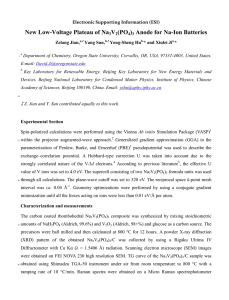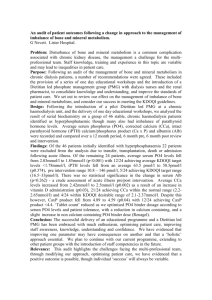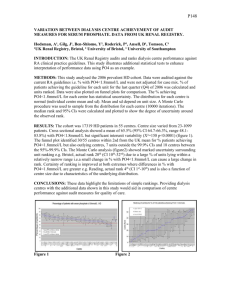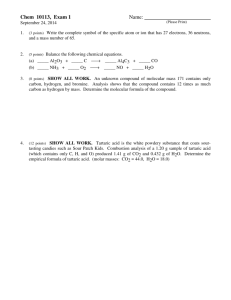Simulations of Li ion diffusion in the electrolyte material – Li PO
advertisement
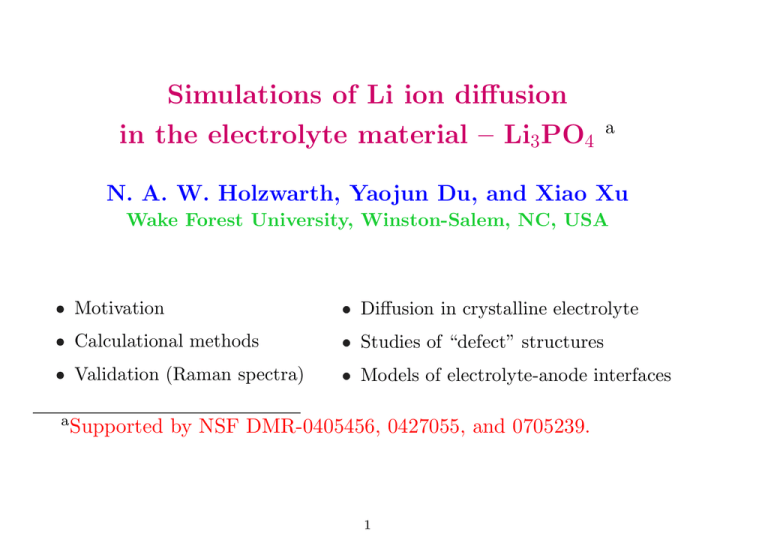
Simulations of Li ion diffusion
in the electrolyte material – Li3 PO4
a
N. A. W. Holzwarth, Yaojun Du, and Xiao Xu
Wake Forest University, Winston-Salem, NC, USA
• Motivation
• Diffusion in crystalline electrolyte
• Calculational methods
• Studies of “defect” structures
• Validation (Raman spectra)
• Models of electrolyte-anode interfaces
a Supported
by NSF DMR-0405456, 0427055, and 0705239.
1
Diagram of discharge operation for a Li-ion
battery
Li+
−
+
Cathode Electrolyte Anode
−
e
V = IR
I
2
LiPON (Li3 PO4 + N) developed at ORNL
Properties
• Chemical and structural stability.
• Reasonable Li+ conductivity.
• Stable contacts with anodes and cathodes.
3
Questions
1. What are the basic mechanisms for Li+ transport in crystalline Li3 PO4 ?
• Migration of Li+ vacancies?
• Migration of Li+ interstitials?
2. What are the effects isolated defects in crystalline Li3 PO4 ; competition
between sources of mobile Li+ ions and trapping effects. Neutral materials
have the stoichiometries: Li3+x PO4−y Nz , with x = 3z − 2y.
• Stable structures for isolated defects.
• Effects of defects on Li+ migration.
3. What happens at the interface between the electrolyte and electrode; ideal
interfaces between crystalline Li3 PO4 and metallic Li.
• Plausible interface structures.
• Migration of Li+ vacancies or interstitials across interface.
4
Summary of “first-principles” calculational
methods
Basic approximations
• All calculations are carried out using supercells composed of 16 Li3 PO4 units.
• Nuclear motions are assumed to be separable from the electronic motions within the
Born-Oppenheimer approximation and are treated classically.
• Electronic effects are treated within density functional theory (DFT) using the local density
approximation (LDA) form of the exchange-correlation functional. (A few results were
obtained using the generalized gradient approximation (GGA) form.) These calculations
determine the “total energy” corresponding to the electronic ground state E({Ra }) and
self-consistent electron density ρ(r, {Ra }) for each set of nuclear coordinates {Ra }.
• Meta-stable configurations are determined by minimizing the total energies and converging
the forces (|∇a E({Ra })| < 0.01 eV/Å).
• Migration energies Em between adjacent metal-stable configurations are determined using
the Nudged Elastic Band method within an estimated error of ±0.05 eV.
5
Codes for electronic structure calculations
Method
Comments
PAW
pwpaw - pwpaw.wfu.edu
socorro - dft.sandia.gov/socorro
abinit - www.abinit.org
Works well for moderately large unit cells,
but variable unit cell optimization not yet implemented in pwpaw and socorro. Need to
construct and test PAW basis and projector
functions.
LAPW
wien2k - www.wien2k.at
Works well for smaller unit cells; variable unit
cell optimization not implemented. Need to
choose non-overlapping muffin tin radii and
avoid “ghost” solutions.
PWscf
pwscf - www.pwscf.org
Works well for large unit cells and includes
variable unit cell optimization. Need to construct and test soft pseudopotential functions.
6
Secret recipe for pseudopotential construction
rc (bohr)
Atomic basis
Li
PAW∗
1.61
1s, 2s, 2p
PWscf†
1.60
1s, 2s, 2p
LAPW
1.70
1s, ²s, ²p
PAW∗
1.41
2s, ²s, 2p, ²p
PWscf†
1.40
2s, ²s, 2p, ²p
LAPW
1.28
2s, ²s, ²p
PAW∗
1.51
2s, 3s, 2p, 3p
PWscf†
1.50
3s, ²s, 3p, ²p, ²d
LAPW
1.38
²s, 2p, ²p
O
P
∗
†
PAW basis and projector functions generated by atompaw code.
Ultra-soft pseudopotentials generated by uspp code of David Vanderbilt.
7
Test results for simple oxides
Li2O
0.5
LDA
∆E (eV)
∆E (eV)
GGA
PWscf
PAW
LAPW
0.8
0.4
0.1
0.2
8.5
9
0
9.5
PWscf
PAW
LAPW
GGA
PWscf
PAW
LAPW
0.6
0.2
0
8
LDA
1
PWscf
PAW
LAPW
0.4
0.3
PO4
1.2
2.8
2.9
3
3.1
b (bohr)
a (bohr)
Fluorite structure
Tetrahedral molecule
8
Validation of calculations –
comparison with Raman spectral data
Exp. A
Exp. B
Exp. C
Exp.
Exp. D
LDA
LDA
GGA
GGA
200
400
600
-1
ν (cm )
800
1000
200
400
600
-1
ν (cm )
800
1000
γ-Li3 PO4
β-Li3 PO4
Exp. A – (RT) – Mavrin & co-workers, JETP 96, 53 (2003);
Exp. B – (RT) – Harbach & co-workers, Phys. Stat. Sol. B
66, 237 (1974); Exp. C – (LNT) – Harbach; Exp. D – (LNT)
Popović & co-workers, J. Raman Spec. 34 77, (2003)
Exp. – (LNT) Popović & co-workers, J. Raman Spec. 34 77,
(2003)
9
Ionic conductivity via activated hopping
Schematic diagram of minimal energy path
Arrhenius relation
Approximated using NEB algorithma
– “Nudged Elastic Band”
σ · T = Ke−EA /kT
From: Ivanov-Shitz and co-workers,
Cryst. Reports 46, 864 (2001):
Em
a
H. Jónsson et al., in Classical and Quantum Dynamics in Con-
densed Phase Simulations, edited by Berne, Ciccotti, and Coker
(World Scientific, 1998), p.
385; G. Henkelman et al, JCP 113,
9901, 9978 (2000).
10
EA = 1.14, 1.23, 1.14, 1.31, 1.24 eV for
1,2,3,4,5, respectively.
Crystalline Li3 PO4
γ
β
7
7
1
43
5
2
6
8
2c
3
5
2
4
2c
6
1
2a
2b
a
2b
Ball and stick drawing of the equilibrium structures of the γ-Li3 PO4 and β-Li3 PO4 supercells
used in the simulations. The PO4 groups are indicated with bonded yellow and blue spheres.
Li ions are indicated by light and dark gray spheres representing the crystallographically
distinct sites. The number labels on some of the Li sites are used to describe vacancy diffusion.
11
Example of configuration coordinate diagrams for
vacancy diffusion in Li3 PO4
1
0.8
0.6
0.4
0.2
1(d)
β
b-axis
Energy (eV)
Energy (eV)
γ
LDA
GGA
4(d)
5(d)
0.8
0.6
0.4
0.2
4(b)
12
a -axis
3(b)
5(b)
Metastable interstitial Li+ configurations in
γ-Li3 PO4
I channel
II channel
2b
2b
II
I
2c
2c
a
a
Ball and stick drawing of the metastable interstitial Li+ sites (indicated with green balls) in
γ-Li3 PO4 . Similar structures occur in β-Li3 PO4 .
13
Example of configuration coordinate diagrams for
interstitial diffusion in Li3 PO4
0.5
b & c axes
0.4
0.3
0.2
0.1
0
I0
β
LDA
GGA
Energy (eV)
Energy (eV)
γ
I0
0.5 a & c axes
0.4
0.3
0.2
0.1
0I
0
14
I0
Illustration of interstitialcy mechanism
along b & c axes in γ-Li3 PO4
15
Illustration of interstitialcy mechanism
along b & c axes in γ-Li3 PO4
16
Illustration of interstitialcy mechanism
along b & c axes in γ-Li3 PO4
17
Illustration of interstitialcy mechanism
along b & c axes in γ-Li3 PO4
18
Illustration of interstitialcy mechanism
along b & c axes in γ-Li3 PO4
19
Illustration of interstitialcy mechanism
along b & c axes in γ-Li3 PO4
20
Illustration of interstitialcy mechanism
along b & c axes in γ-Li3 PO4
21
Illustration of interstitialcy mechanism
along b & c axes in γ-Li3 PO4
22
Illustration of interstitialcy mechanism
along b & c axes in γ-Li3 PO4
23
Li+ ion energies in bulk γ-Li3 PO4 crystalsa
Em
EA = Em + Ef /2b
a (vacancy)
0.7 eV
1.5 eV
a (interstitial)
0.4 eV
1.3 eV
b (vacancy)
0.7 eV
1.5 eV
b (interstitial)
0.3 eV
1.1 eV
c (vacancy)
0.7 eV
1.5 eV
c (interstitial)
0.3 eV
1.1 eV
Axis
a
EA (exp)c
1.23 eV
1.14 eV
1.14 eV
Yaojun Du and N. A. W. Holzwarth, PRB 76, 174302 (2007).
b
Ef ≈ 1.7 eV.
c
Ivanov-Shitz et al, Cryst. Reports 46, 864 (2001).
24
Defect structures – γ-Li3− 161 PO4− 162 N 161
Stable “bent” P−N−P structure
7
8
6
2c
54
2
3
1
2b
a
Ideal supercell
Relaxed structure
25
Defect structures – γ-Li3− 161 PO4− 162 N 161
Stable “bent” P−N−P and P−O−P structures
Contours of electron density
Contours of electron density
for “bent” P−N−P structure
for “bent” P−O−P structure
26
Defect structures – γ-Li3− 161 PO4− 162 N 161
Stable “straight” P−N−P structure
7
2c
6
5
4
2
1
3
2b
a
Ideal supercell
Relaxed structure
27
Defect structures – γ-Li3− 161 PO4− 162 N 161
Stable “straight” P−N−P and P−O−P structures
Contours of electron density
Contours of electron density
for “straight” P−N−P structure
for “straight” P−O−P structure
28
Summary of properties of defect structures in
γ-Li3 PO4 .
Bond lengths, angles, and relative supercell energies for P−N−P and P−O−P
structures.
∗
Type
Bond lengths (Å)∗
Bond angle
Energy (eV)
P−N−P (bent)
1.63, 1.66
118(o )
0.00
P−N−P (straight)
1.63, 1.62
174(o )
0.05
P−O−P (bent)
1.66, 1.70
122(o )
2.71
P−O−P (straight)
1.69, 1.66
171(o )
2.59
For comparison, tetrahedral P−O bonds are calculated to be 1.54-1.57 Å.
29
Effects of PNP structures on Li+ vacancy
migration energies
Vacancy diffusion along b-axis
in γ-Li3PO4
Vacancy diffusion along b-axis
in Li3-1/16PO4-2/16N1/16 (bent PNP)
0.5
0
-0.5
-1
#1
Em=0.7 eV
#4
1
Energy (eV)
Energy (eV)
1
0.5
0
-0.5
-1
#2’
#5
30
Em=1.3 eV
#4’
#5’
Li+ ion energies in dopped γ-Li3 PO4 crystals
Em (perfect crystal)a
Em (dopped crystal)
a (vacancy)
0.7 eV
0.8 eVb
a (interstitial)
0.4 eV
b (vacancy)
0.7 eV
1.3 eVb
b (interstitial)
0.3 eV
0.7-0.9 eVc
c (vacancy)
0.7 eV
0.9 eVb
c (interstitial)
0.3 eV
0.7-0.9 eVc
Axis
a
Yaojun Du and N. A. W. Holzwarth, PRB 76, 174302 (2007).
b
Li3−1/16 PO4−2/16 N1/16 in bent PNP structure.
c
Li3+1/16 PO4−1/16 N1/16 for various N substitution positions.
⇒ Isolated defects trap Li+ ions.
31
Interfaces between Li3 PO4 and Li metal
Normal axis
Simulation supercell geometry
Diffusion mechanism
vacancy
a-axis:
2c
2b
2a
b-axis:
interstitial
a
2c
4b
c-axis:
interstitial
a
2b
4c
32
N(E) (states/(eV.sphere))
Partial densities of states interfaces (along a-axis)
1
0.5
EF
0
Li (metallic)
Li (electrolyte)
P (electrolyte)
O (electrolyte)
vacuum states
1
0.5
EF
0
-8
-6
-4
-2
0
E (eV)
33
2
4
6
8
Vacancy diffusion across interface in a-direction
via direct hopping mechanism
0.5
Em (eV)
0.4
0.3
0.2
0.1
Em=0.4 eV
0
Metal vacancy
Electrolyte vacancy
Reference configuration
34
Comparison of Li ion migration energies for bulk
and interface diffusion in γ-Li3 PO4
Em (bulk crystal)a
Em (interface)
a (vacancy)
0.7 eV
0.4 eV
a (interstitial)
0.4 eV
??
b (vacancy)
0.7 eV
0.2 eV
b (interstitial)
0.3 eV
0.2-0.3 eV
c (vacancy)
0.7 eV
??
c (interstitial)
0.3 eV
0.3 eV
Axis
a
Yaojun Du and N. A. W. Holzwarth, PRB 76, 174302 (2007).
⇒ Em (interface) ≤ Em (bulk).
35
Questions
1. What are the basic mechanisms for Li+ transport in crystalline Li3 PO4 ?
• Migration of Li+ vacancies?
• Migration of Li+ interstitials?
2. What are the effects isolated defects in crystalline Li3 PO4 ; competition
between sources of mobile Li+ ions and trapping effects. Neutral materials
have the stoichiometries: Li3+x PO4−y Nz , with x = 3z − 2y.
• Stable structures for isolated defects.
• Effects of defects on Li+ migration.
3. What happens at the interface between the electrolyte and electrode; ideal
interfaces between crystalline Li3 PO4 and metallic Li.
• Plausible interface structures.
• Migration of Li+ vacancies or interstitials across interface.
36
Some Answers
1. What are the basic mechanisms for Li+ transport in crystalline Li3 PO4 ?
• Migration of Li+ vacancies? Em ≈ 0.6 − 0.7 eV .
• Migration of Li+ interstitials? Em ≈ 0.3 − 0.5 eV .
• Good agreement with activation energy measurements on γ-Li3 PO4
EA = Em + Ef /2 ≈ 1.1 − 1.3 eV .
2. What are the effects isolated defects in crystalline Li3 PO4 ; competition between sources of
mobile Li+ ions and trapping effects. Neutral materials have the stoichiometries:
Li3+x PO4−y Nz , with x = 3z − 2y.
• Stable structures for isolated defects; for z = 2y = −x = 1/16 find
rebonded P−N−P and P−O−P structures . Also studied z = y = x = 1/16.
• Effects of defects on Li+ migration – Isolated defects within crystalline Li3 PO4 tend to
trap Li+ ions and increase their migration energies .
3. What happens at the interface between the electrolyte and electrode; ideal interfaces
between crystalline Li3 PO4 and metallic Li.
• Plausible interface structures – idealized model interfaces along a, b, and c axes are
found to be physically and chemically stable .
• Migration of Li+ vacancies or interstitials across interface. Find
Em (interface) ≤ Em (bulk) .
37

